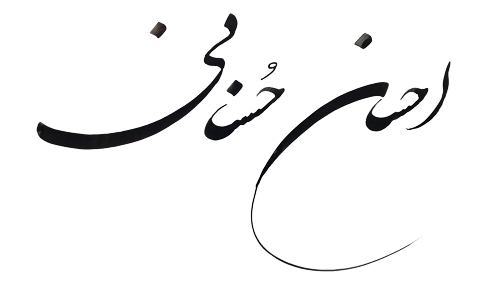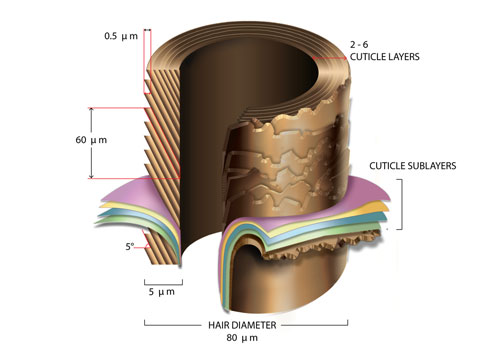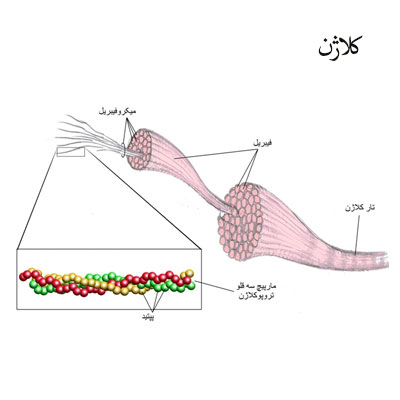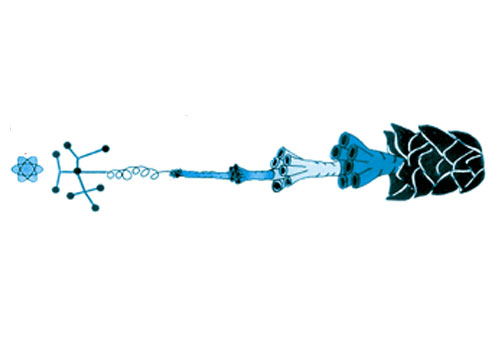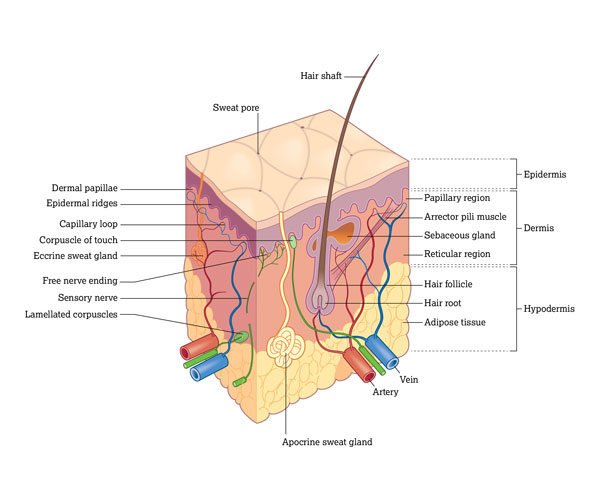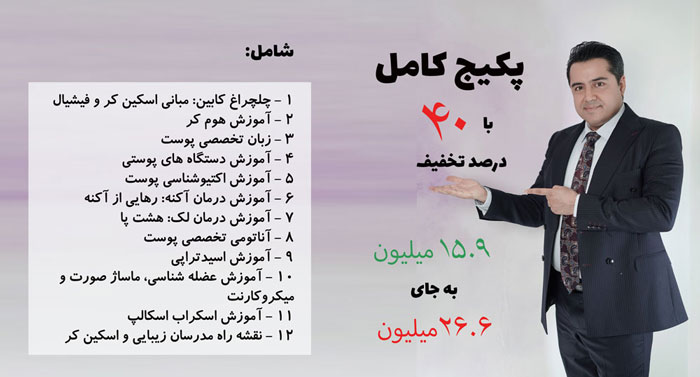اسید آمینه = amino acid
نویسنده:
چکیده: معادل انگلیسی کلمه یا واژه اسید آمینه، Amino Acid می باشد.
اسید آمینه چیست؟
اسید آمینه = Amino Acid
amino acid = آمینو اسید، اسید آمینه
ALGAE EXTRACT — A blend of different varieties of red algae, this powerful nutrient is rich in amino acids, antioxidant vitamin C and vitamin B-12. (INCI dictionary)
عصاره جلبك: آميزه اي از انواع مختلف جلبك هاي قرمز، غني از اسيدهاي آمينه، آنتي اكسيدان، ويتامين C و ويتامين ب 12.
AMINO ACIDS — Amino acids are “the building blocks” that make up proteins. Because proteins are necessary to every living cell and are involved in every major process in the body, amino acids are essential to health. Of the roughly 28 known amino acids, 80 percent are manufactured by the body. The others, known as essential amino acids, must be obtained from the diet. Amino acids support proteins in the skin (collagen, elastin, etc.) and, used in certain combinations, help regulate oil production in the skin and scalp. Human hair is made up of 18 amino acids, which is why many quality hair care products contain them. (INCI dictionary)
اسيدهاي آمينه: اجزاي سازنده پروتئين ها هستند. پروتئين ها براي هر سلول زنده ضروري هستند. حدوداً 28 نوع اسيد آمينه شناخته شده است. 80 درصد آنها توسط بدن ساخته مي شود. بقيه آنها كه به آنها اسيدهاي آمينه ضروري مي گويند بايد توسط رژيم غذايي بدن تأمين گردد. آمينواسيدها پروتئين هاي پوست (مثل كلاژن و الاستين) را حمايت مي كند. موي انسان 18 اسيد آمينه دارد، به همين علت در تركيبات محصولات مراقبت از پوست از اسيدهاي آمينه استفاده مي شود.
APHANIZOMENON FLOS AQUAE — Blue Green Algae. Made up of 50% to 70% utilizable protein, blue green algae is an excellent food, used for thousands of years for its mild taste and easily assimilated nutrients. A good source of enzymes, minerals, trace minerals and antioxidants, its amino acid profile is virtually identical to that of humans, which makes it more readily absorbed by the skin. Used in hair care products for its protein content, it helps revitalize and condition dull, damaged hair. (INCI dictionary)
CARNOSINE — Naturally occurring combination of the amino acids histidine and alanine, used in skin care products for its pro- tective and skin rejuvenating proper ties. An antioxidant and anti-in- flammatory, it protects collagen and elastin fibers in the skin from oxidative stress, improves elasticity and reduces wrinkles and other signs of aging. (INCI dictionary)
CHENOPODIUM QUINOA — Quinoa Protein. One of the most complete plant proteins, high in vitamins, minerals and the sulfur- containing amino acids cystine and cysteine, excellent nutrients for the hair, scalp and skin. A fixative in hair styling products, it smoothes layers in the hair’s cuticle to strengthen hair fiber, reduce frizzing and enhance shine. Used in anti-aging creams and facial masks, it firms and nourishes the skin for a more youthful appearance. CHLORELLA PYRENOIDOSA — Chlorella. Made up of over 60% protein, this green micro-algae contains all the essential amino acids, and is high in chlorophyll and vitamin B. An excellent nutrient, often used as a skin hydrator. (INCI dictionary)
CITRULLINE — An amino acid found in the skin of watermelon, sometimes known as L-Citrulline. An antioxidant and conditioning agent used in anti-aging formulas for its water-binding proper ties on the skin. (See also Citrullus lanatus.) (INCI dictionary)
COCONUT FATTY ACID CREAM BASE — Absorption base containing essential fatty acids, coconut fatty alcohols from palm ker- nels, aloe vera and vitamins A, C and E. Rich in linoleic and linolenic acids (vitamin F), excellent nutrients and skin conditioners. In hair care products, it is often combined with the impor tant amino acids cysteine and methionine, which are high in sulfur and excellent for the hair and scalp. (INCI dictionary)
CYSTEINE, CYSTINE — Sulfur-rich amino acids, very beneficial to the hair and skin. (See also Amino Acids.) (INCI dictionary)
FUCUS VESICULOSUS EXTRACT — Bladderwrack. Seaweed rich in alginic acid, amino acids, polysaccharides, minerals and vitamins. Its essential oil is a stimulant and tonic. It is often used in massage lotions and some hair and scalp care products. (INCI dictionary)
GLUTAMIC ACID — An amino acid. (See Amino Acids.) (INCI dictionary)
GLYCOPROTEIN — A protein linked to a polysaccharide (glycogen). Glycoproteins (ours are derived from yeast) contain sugars and amino acids, which help strengthen and smooth hair fiber. (INCI dictionary)
HYDROLYZED VEGETABLE PROTEIN — Termed the building block of life, protein is our most import tant food, a leading source of vitamins and essential amino acids. Generally found in meats, eggs and dairy y products, protein can also be obtained from soy, wheat and other plant sources. Applied topically, vegetable protein is an excellent hydrator, readily absorbed by the skin for improved tex- ture. In hair care formulas, it combines with fatty acids and amino acids to coat porous or damaged hair and split ends. (See also Hy- drolyzed oat protein, Hydrolyzed soy protein, Hydrolyzed wheat protein.) (INCI dictionary)
ILEX PARAGUAYENSIS — Mate, Yerba Mate. This rainforest native is a powerful anti-inflammatory and nutrient, high in vitamins and amino acids. (INCI dictionary)
LACTALBUMIN — Lactis proteinum. Milk protein, high in lactic acid and containing the eight essential amino acids. It has been labeled “the most perfect protein.” An excellent ingredient in conditioners for dry or damaged hair. (INCI dictionary)
LAUROYL LYSINE — Fine powder derived from the amino acid lysine and lauric acid from coconut. Adds a silky feel to makeup powders. (INCI dictionary)
LYSINE — See Amino Acids; Lauroyl lysine. (INCI dictionary)
METHIONINE — Sulfur-rich amino acid, very beneficial to the hair and skin. (See also Amino Acids.) (INCI dictionary)
MILK PROTEIN — Lactalbumin. Protein high in lactic acid and containing the eight essential amino acids. It has been labeled “the most perfect protein.” An excellent ingredient in conditioners for dry or damaged hair. (INCI dictionary)
PERSEA GRATISSIMA — Avocado Oil. A good source of vitamins A, D and E, amino acids and sterols. Herbalists traditionally have used avocado oil in hair and scalp preparations and in the treatment of chronic dry skin conditions. Easily absorbed by the skin and scalp, it is very soothing and nourishing. (INCI dictionary)
PROLINE — An amino acid. (See Amino Acids.) (INCI dictionary)
ROYAL JELLY — Substance secreted in the digestive tube of worker bees. A powerful nutrient high in amino acids, minerals and vitamins A, B, C and E.Very soothing and moisturizing to the skin. (INCI dictionary)
SILK POWDER — Used in makeup powders to even out skin tones and leave the complexion soft and smooth. Obtained from silk threads, it is high in amino acids and vitamin E. (INCI dictionary)
SIMMONDSIA CHINENSIS SEED POWDER — Jojoba Meal. High in protein and natural fibers, this byproduct of the moisture-rich jojo- ba plant contains 17 amino acids. Its mild exfoliating properties help clear away dead skin cells and nourish and deep-cleanse the complex- ion without drying it out. (INCI dictionary)
SODIUM COCOYL GLUTAMATE — Derived from coconut oil and glutamate amino acid. Acts as an emulsifier and has a protective and moisturizing effect on the skin. (INCI dictionary)
SODIUM PCA — Salt of glutamic acid, an amino acid that occurs widely in food. Used in appropriate concentrations, it acts as a hu- mectant to help attract and retain moisture to the skin. (INCI dictionary)
ARGININE: An amino acid that binds to the pure glycolic acid molecule. Once bonded, it allows for controlled delivery of glycolic acid into the skin over a prolonged period of time thus reducing irritation that usually accompanies AHA use. Promotes collagen synthesis and increases skin elasticity. (cellularskinrx.com)
ERGOTHIONEINE: Ergothioneine is a chirally-correct anti-oxidant amino acid superior to CoQ10 and Idebenone. It helps wake up sluggish, stressed skin cells and protects against oxidative stress caused by sugar, browned foods, alcohol, UV light, pollution and stress. A key energizing antioxidant for skin cells. (cellularskinrx.com)
Cystine: An amino acid found in urine and horsehair. Used as a nutritional supplement and in emollients. Alternatives: plant sources. (peta.org)
Amino Acids: The building blocks of protein in all animals and plants. In cosmetics, vitamins, supplements, shampoos, etc. Alternatives: synthetics, plant sources. (peta.org)
Tyrosine: Amino acid often of plant or synthetic origin but sometimes hydrolyzed from casein (milk). Used in cosmetics and creams. Derivative: Glucose Tyrosinase. (peta.org)
Methionine: Essential amino acid found in various proteins (usually from egg albumen and casein). Used as a texturizer and for freshness in potato chips. Alternatives: synthetics. (peta.org)
Cysteine, L-Form: An amino acid from hair that can come from animals. Used in hair-care products and creams, in some bakery products, and in wound-healing formulations. Alternatives: plant sources. (peta.org)
Bee Pollen: Microsporic grains in seed plants gathered by bees then collected from the legs of bees. Causes allergic reactions in some people. In nutritional supplements, shampoos, toothpastes, deodorants. Alternatives: synthetics, plant amino acids, pollen collected from plants. (peta.org)
Clay Lighteners: Clay lighteners are lightening powders that contain organic pigments and also (they claim) 17 amino acids, silk extracts, olive oil, panthenol and milk, as well as being ammonia free. They are not clay at all and are simply promoted as natural and better for the condition of the hair. They are effective, but can easily be over-processed and can cause serious damage to the hair shaft if adequate care is not taken. (thehairstyler.com)
Calendula Officinalis Flower Extract, Peg-33 Castor Oil (Dérivé D'huile De Ricin), Sodium Lauroyl Oat Amino Acids, Salvia Officinalis (Sage) Oil (Sauge), Citrus Medica Limonum (Lemon) Peel Oil (Citron), Rosmarinus Officinalis ( Rosemary) Leaf Oil (Romarin), Juniperus Communis Fruit Oil (Baie De Genièvre), Palmitoyl Hydrolyzed Wheat Protein (Dérivé D'acides Aminés De Blé), Vinegar / Acetum, Propylene Glycol, Citral, Limonene, Phenoxyethanol*, Parabens (Butyl, Ethyl)*, Methylisothiazolinone*, Methylchloroisothiazolinone*, Polysorbate 20, Beta-Carotene. (Huile d ales ingredients)
amino acids = اسیدهای آمینه
ALGAE EXTRACT — A blend of different varieties of red algae, this powerful nutrient is rich in amino acids, antioxidant vitamin C and vitamin B-12. (INCI dictionary)
عصاره جلبك: آميزه اي از انواع مختلف جلبك هاي قرمز، غني از اسيدهاي آمينه، آنتي اكسيدان، ويتامين C و ويتامين ب 12.
AMINO ACIDS — Amino acids are “the building blocks” that make up proteins. Because proteins are necessary to every living cell and are involved in every major process in the body, amino acids are essential to health. Of the roughly 28 known amino acids, 80 percent are manufactured by the body. The others, known as essential amino acids, must be obtained from the diet. Amino acids support proteins in the skin (collagen, elastin, etc.) and, used in certain combinations, help regulate oil production in the skin and scalp. Human hair is made up of 18 amino acids, which is why many quality hair care products contain them. (INCI dictionary)
اسيدهاي آمينه: اجزاي سازنده پروتئين ها هستند. پروتئين ها براي هر سلول زنده ضروري هستند. حدوداً 28 نوع اسيد آمينه شناخته شده است. 80 درصد آنها توسط بدن ساخته مي شود. بقيه آنها كه به آنها اسيدهاي آمينه ضروري مي گويند بايد توسط رژيم غذايي بدن تأمين گردد. آمينواسيدها پروتئين هاي پوست (مثل كلاژن و الاستين) را حمايت مي كند. موي انسان 18 اسيد آمينه دارد، به همين علت در تركيبات محصولات مراقبت از پوست از اسيدهاي آمينه استفاده مي شود.
CARNOSINE — Naturally occurring combination of the amino acids histidine and alanine, used in skin care products for its pro- tective and skin rejuvenating proper ties. An antioxidant and anti-in- flammatory, it protects collagen and elastin fibers in the skin from oxidative stress, improves elasticity and reduces wrinkles and other signs of aging. (INCI dictionary)
CHENOPODIUM QUINOA — Quinoa Protein. One of the most complete plant proteins, high in vitamins, minerals and the sulfur- containing amino acids cystine and cysteine, excellent nutrients for the hair, scalp and skin. A fixative in hair styling products, it smoothes layers in the hair’s cuticle to strengthen hair fiber, reduce frizzing and enhance shine. Used in anti-aging creams and facial masks, it firms and nourishes the skin for a more youthful appearance. CHLORELLA PYRENOIDOSA — Chlorella. Made up of over 60% protein, this green micro-algae contains all the essential amino acids, and is high in chlorophyll and vitamin B. An excellent nutrient, often used as a skin hydrator. (INCI dictionary)
COCONUT FATTY ACID CREAM BASE — Absorption base containing essential fatty acids, coconut fatty alcohols from palm ker- nels, aloe vera and vitamins A, C and E. Rich in linoleic and linolenic acids (vitamin F), excellent nutrients and skin conditioners. In hair care products, it is often combined with the impor tant amino acids cysteine and methionine, which are high in sulfur and excellent for the hair and scalp. (INCI dictionary)
CYSTEINE, CYSTINE — Sulfur-rich amino acids, very beneficial to the hair and skin. (See also Amino Acids.) (INCI dictionary)
FUCUS VESICULOSUS EXTRACT — Bladderwrack. Seaweed rich in alginic acid, amino acids, polysaccharides, minerals and vitamins. Its essential oil is a stimulant and tonic. It is often used in massage lotions and some hair and scalp care products. (INCI dictionary)
GLUTAMIC ACID — An amino acid. (See Amino Acids.) (INCI dictionary)
GLYCOPROTEIN — A protein linked to a polysaccharide (glycogen). Glycoproteins (ours are derived from yeast) contain sugars and amino acids, which help strengthen and smooth hair fiber. (INCI dictionary)
HYDROLYZED VEGETABLE PROTEIN — Termed the building block of life, protein is our most import tant food, a leading source of vitamins and essential amino acids. Generally found in meats, eggs and dairy y products, protein can also be obtained from soy, wheat and other plant sources. Applied topically, vegetable protein is an excellent hydrator, readily absorbed by the skin for improved tex- ture. In hair care formulas, it combines with fatty acids and amino acids to coat porous or damaged hair and split ends. (See also Hy- drolyzed oat protein, Hydrolyzed soy protein, Hydrolyzed wheat protein.) (INCI dictionary)
ILEX PARAGUAYENSIS — Mate, Yerba Mate. This rainforest native is a powerful anti-inflammatory and nutrient, high in vitamins and amino acids. (INCI dictionary)
LACTALBUMIN — Lactis proteinum. Milk protein, high in lactic acid and containing the eight essential amino acids. It has been labeled “the most perfect protein.” An excellent ingredient in conditioners for dry or damaged hair. (INCI dictionary)
LYSINE — See Amino Acids; Lauroyl lysine. (INCI dictionary)
METHIONINE — Sulfur-rich amino acid, very beneficial to the hair and skin. (See also Amino Acids.) (INCI dictionary)
MILK PROTEIN — Lactalbumin. Protein high in lactic acid and containing the eight essential amino acids. It has been labeled “the most perfect protein.” An excellent ingredient in conditioners for dry or damaged hair. (INCI dictionary)
PERSEA GRATISSIMA — Avocado Oil. A good source of vitamins A, D and E, amino acids and sterols. Herbalists traditionally have used avocado oil in hair and scalp preparations and in the treatment of chronic dry skin conditions. Easily absorbed by the skin and scalp, it is very soothing and nourishing. (INCI dictionary)
PROLINE — An amino acid. (See Amino Acids.) (INCI dictionary)
ROYAL JELLY — Substance secreted in the digestive tube of worker bees. A powerful nutrient high in amino acids, minerals and vitamins A, B, C and E.Very soothing and moisturizing to the skin. (INCI dictionary)
SILK POWDER — Used in makeup powders to even out skin tones and leave the complexion soft and smooth. Obtained from silk threads, it is high in amino acids and vitamin E. (INCI dictionary)
SIMMONDSIA CHINENSIS SEED POWDER — Jojoba Meal. High in protein and natural fibers, this byproduct of the moisture-rich jojo- ba plant contains 17 amino acids. Its mild exfoliating properties help clear away dead skin cells and nourish and deep-cleanse the complex- ion without drying it out. (INCI dictionary)
Amino Acids: The building blocks of protein in all animals and plants. In cosmetics, vitamins, supplements, shampoos, etc. Alternatives: synthetics, plant sources. (peta.org)
Bee Pollen: Microsporic grains in seed plants gathered by bees then collected from the legs of bees. Causes allergic reactions in some people. In nutritional supplements, shampoos, toothpastes, deodorants. Alternatives: synthetics, plant amino acids, pollen collected from plants. (peta.org)
Clay Lighteners: Clay lighteners are lightening powders that contain organic pigments and also (they claim) 17 amino acids, silk extracts, olive oil, panthenol and milk, as well as being ammonia free. They are not clay at all and are simply promoted as natural and better for the condition of the hair. They are effective, but can easily be over-processed and can cause serious damage to the hair shaft if adequate care is not taken. (thehairstyler.com)
Calendula Officinalis Flower Extract, Peg-33 Castor Oil (Dérivé D'huile De Ricin), Sodium Lauroyl Oat Amino Acids, Salvia Officinalis (Sage) Oil (Sauge), Citrus Medica Limonum (Lemon) Peel Oil (Citron), Rosmarinus Officinalis ( Rosemary) Leaf Oil (Romarin), Juniperus Communis Fruit Oil (Baie De Genièvre), Palmitoyl Hydrolyzed Wheat Protein (Dérivé D'acides Aminés De Blé), Vinegar / Acetum, Propylene Glycol, Citral, Limonene, Phenoxyethanol*, Parabens (Butyl, Ethyl)*, Methylisothiazolinone*, Methylchloroisothiazolinone*, Polysorbate 20, Beta-Carotene. (Huile d ales ingredients)
Peptide = short chains of amino acids = پپتیدها = رشته های کوتاه از اسیدهای آمینه
amino acids
اسیدهای آمینه
اسیدهای آمینه
واژه «اسید آمینه» در مقالات سایت احسان حسنانی
نفوذ به پوست - قسمت اول کاهش اندازه ذرات
پوست انسان سد نفوذ ناپذیری است که مواد به آسانی به داخل آن نفوذ نمی کند. به همین دلیل باید راه هایی پیدا کرد که بتوانیم مواد موثره و ترکیبات دارویی را به داخل پوست وارد کنیم. یکی از این راه ها که ساده ترین آن ها هم هست، این است که سایز آنها را کاهش دهیم. مثلا کلاژن و الاستین مولکول های بزرگی هستند و به راحتی به پوست نفوذ نمی کنند. آنها از جنس پروتئین هستند. ولی اگر پروتئین را کوچک کنیم به پپتیدها واسیدهای آمینه تبدیل می شوند. پپتیدها و اسیدهای آمینه راحت تر به داخل پوست نفوذ میکنند. یا مثلا هیالورونیک اسید یک مولکول پلیمری است و از تعداد زیادی واحد همشکل تشکیل شده است. کوچک کردن سایز هیالورونیک اسید می تواند به افزایش نفوذ آن کمک کند.
اسید آمینه چیست؟ واحدهای پروتئین است. یعنی شما یک مولکول پروتئین را بگیر ریزش کن، ریز ریزش کن تبدیل به اسید آمینه می شود. ببینید ساختار پروتئین این جا نشان داده شده است. یک اسید آمینه استn تا تکرار شده است.
مشاهده مطلبکاربرد پپتید (پپتاید) در صنایع آرایشی بهداشتی
به تازگی بایوپپتیدهایی ساخته شده که قادر به از بین بردن خطوط و چروکهای پوست هستند. پپتیدها، پروتئین های کوچکی هستند که بسیاری از مولکول های حیاتی بدن از جنس آن است. برخی پپتیدها، پیام رسان هستند. برخی در بدن گشت زنی می کنند و برای سلول ها تعیین تکلیف می کنند. مثلاً پپتیدی به نام فاکتور رشد هپاتوسیت وجود دارد که به فیبروبلاست دستور کلاژن سازی بیشتر را می دهد. یا پپتیدی به نام ملانوتروپین وجود دارد که ملانوسیت ها را برای کمتر یا بیشتر ساختن ملانین تحریک می کند. در این مقاله با پپتیدها بیشتر آشنا می شویم.
پپتید چیست؟
پتیدها پروتئین های خیلی کوچک یا مینی پروتئینها هستند. پروتئین ها ملکولهای بزرگی هستند که از اتصال تعداد زیادی اسید آمینه تشکیل شده اند. یک پروتئین می تواند از یک صد تا چندصدهزار اسیدآمینه تشکیل شده باشد. حال اگر تعداد این اسیدهای آمینه به چند عدد کاهش یاید، چیزی که باقی می ماند همان پپتید است.
بسیاری از ملکولهای حیاتی بدن پپتید هستند. برخی از پپتیدهای طبیعی مهم بدن که در دنیای آرایشی بهداشتی اهمیت دارند عبارتند از فاکتور رشد هپاتوسیت (1) ، فاکتور رشد انتقالی (2)، ملانوتروپین یا هورمون تحریک کننده ملانین (3). این پپتیدها می توانند در نقش پیام رسان عمل کنند. به این معنا که در درون بدن گشت زنی کنند و به سلول های مختلف بگویند که چه کار بکنند و چه کاری نکنند. مثلا فاکتور رشد هپاتوسیت می تواند به فیبروبلاست بگوید که کلاژن بیشتری بساز! یا مثلا ملانوتروپین می تواند به ملانوسیت بگوید که ملانین کمتری یا ملانین بیشتزی بساز!
عکس و نقل از Dr Kadir Laboratories
ترکیبات شبه بوتاکس (مثل آرژیرلین) چگونه عمل می کنند؟
در کنار بایوپپتیدهای پیام رسان (10)، نوع دیگری از بایوپپتیدها به نام نوروپپتیدها (11) نیز وجود دارند. این ها همان ترکیبات شبه بوتاکس هستند که به تازگی مرتب تبلیغشان را می شنویم. این ترکیبات از انتقال علائم عصبی به ماهیچه های پوست جلوگیری می کنند و اجازه نمی دهند که ماهیچه های پوست منقبض شوند. وقتی ماهیچه های پوست نتوانند منقبض شوند چروک ها نیز تشکیل نمی شوند. کرم های حاوی این ماده غالباً با نامهایی مثل رینکل ریلکس (12) یا ریلکسور (13) معرفی می شوند.
پپتیدهای طبیعی یا گیاهی
از دیدگاه شیمی پپتیدها ترکیباتی هستند که از اتصال چند واحد اسید آمینه تشکیل شده اند.
پروتئین ها در واقع پلیمرهای اسید آمینه هستند و پلی پپتید هم خوانده می شوند.
وقتی پروتئین هیدرولیز می شود ترکیبات حاصل از هیدرولیز ممکن است اسیدهای آمینه یا ترکیبات حاصل از چند اسید آمینه به نام پپتید باشد. به همین علت پروتئین های هیدرولیز شده را پپتید نیز می نامند.
مشاهده مطلبکوتیکول مو چیست؟
بیرونی ترین لایه ساقه مو کوتیکول است. حدود 10 درصد از وزن مو را کوتیکول تشکیل می دهد.
3. لایه A (A layer) لایه A محکم ترین بخش از کوتیکول می باشد. کراتین موجود در این لایه غنی از اسید آمینه سیستئین می باشد (حدود 30%) که امکان ایجاد پل های عرضی دی سولفید در بین رشته های کراتین و استحکام بیشتر آن را سبب می شود، که در ادامه بحث به آن پرداخته خواهد شد.
4. کوتیکول خارجی (exocuticle) در این لایه میزان اسید آمینه سیستئین کمتر از لایه A می باشد (حدود 15%) که همین امر سبب کاهش استحکام آن می گردد.
مشاهده مطلبکلاژن چیست؟
حدود ۷۷% از وزن خشک بدون چربی درم، از کلاژن تشکیل یافته است.
کلاژن بدن انسان، حاوی نوع اسید آمینه است که نوع از آن ها در درم دیده می شود. این پلیمر به شکل یک شبکه نامنظم از فیبرهای موج دار به هم تنیده است که به موازات سطح پوست در درم قرار گرفته اند.
مشخصه کلاژن حضور دو اسید آمینه خاص به نامهای هیدروکسی لایسین و هیدروکسی پرولین است. با اندازه گیری میزان هیدروکسی پرولین می توان مقدار کلاژن سنتز شده توسط سلول را مشخص نمود. همچنین می توان مقدار کلاژن تخریب شده در اثر یک بیماری یا در خلال برخی فرایندهای فیزیولوژیکی را مشخص نمود.
آیا کلاژن را می توان به عنوان یکی از اجزاء محصولات آرایشی بهداشتی استفاده نمود؟
کلاژن یک پروتئین بزرگ است که آب را به خود جذب می کند. به همین علت مرطوب کننده خوبی محسوب می شود. اما با توجه به اینکه از سطح پوست جذب نمی شود، اثراتی که در مورد آن ادعا می شود، مثل اثر پیشگیری از چین و چروک را براورده نمی کند.
مشاهده مطلبپوشش اسیدی چیست؟
پوشش اسیدی پوست، مسئول حفاظت از پوست در برابر آلودگی ها، سموم و باکتری ها است.
ترکیبات تشکیل دهنده روکش اسیدی پوست
مواد محلول در آب روکش اسیدی دو دسته هستند. مواد معدنی و آلی .
ترکیبات معدنی موجود در روکش اسیدی پوست شامل یون های سدیم، پتاسیم، منیزیم، کلسیم و انواع آنیون ها نظیر کلریدها و ... است.
اسیدهای آلی روکش اسیدی پوست
بخش آلی عمدتاً از اسید لاکتیک، اسید سیتریک، اسید بوتیریک، اسید اسکوریک، اوره، آثاری از اسید اوریک با مقادیر اندکی از پلی پپتیدها و اسیدهای آمینه مشاهده می شود.
اسیدهای آمینه روکش اسیدی پوست
مهم ترین اسیدهای آمینه سطح پوست شامل اسید گلوتامیک، اسید اسپارتیک، آرژینین، هیستیدین، لیزین، آلانین، سرین، لوسین، والین، پرولین، گلیکوکول، فنیل آلانین و تیروزین می باشد. در مجموع متجاوز از اسید آمینه در سطح پوست شناسایی شده است. این اسیدها خیلی زود در سطح پوست تشکیل می شوند و از زمان طفولیت و همان هفته های نخست تولد، تقریباً تمام اسیدهای آمینه موجود در پوست بالغین را می توان در پوست اطفال نیز پیدا نمود ولی از نظر کمی با هم اختلاف دارند. منشأ این اسیدهای آمینه چندان مشخص نیست، بعضی از این اسیدها را می توان در ترکیب عرق و همین طور در ترشحات غدد مولد چرب پیدا نمود، بعضی ها از خود اپیدرم ناشی می شوند، به ویژه از طبقات عمقی اپیدرم و تنها اسید آمینه ای که منشأ آن طبقه شاخی است هیستیدین است.
مشاهده مطلبپروتئین ملانوتروپین در محصولات آرایشی بهداشتی
ملانوتروپین، هورمون ملانین سازی و به عبارت دیگر هورمون تحریک کننده ملانوسیت است. این ماده طبیعی در برنزه شدن پوست نقش دارد. ملانوتروپین یک پپتید 13 تائی است که 7 پپتید 4 تا 10 مسئول فعالیت ملانوتروپ و 3 پپتید 11 تا 13 مسئول اثر ضد التهابی می باشند. آگونیست ها و آنتاگونیست های هورمون ملانوتروپین در این بخش توضیح داده شده است.
تیروزیناز با تثبیت α-MSH بر روی رسپتور ویژه اش یعنی MC1-R تحریک می شود. تیروزیناز در اثر تحریک، اسید آمینه تایروسین را هیدروکسیل دار نموده و آن را به دی هیدروکسی فنیل آلانین (DOPA) تبدیل می کند. سپس واکنش اکسیداسیون DOPA و تبدیل آن به «DOPA – کوئینون» را کاتالیز می کند. مرحله نهایی سنتز ملانین در اندامک هایی به نام ملانوزوم در [سلول های] ملانوسیت انجام می شود. α-MSH یک پپتید سیزده تایی (تری-دکاپپتید ) با فرمول زیر است.
Melanotropin (α-MSH): Acetyl-Ser-Tyr-Ser-Met-Glu-His-Phe-Arg-Trp-Gly-Lys-Pro-Val-NH2
اثبات شده که توالی فعال α-MSH که مسئول فعالیت ملانوتروپ است، هفت پپتید 4 تا 10 می باشد.
در حالیه که سه پپتید 11 تا13 مسئول اثر ضدالتهابی است.
اتصال α-MSH (به عنوان یک لیگاند طبیعی و فیزیولوژیک) به رسپتور MC1بر روی سلول های ملانوسیت اولین مرحله در ملانین سازی و تشکیل رنگدانه است. با مسدود کردن رسپتور MC1می توان مسیر ملانین سازی درون سلولی را مهار نموده و از سنتز بیش از حد ملانین توسط ملانوسیت ها جلوگیری به عمل آورد. برای دستیابی به این مهم می توان از آنتاگونیست های α-MSH استفاده نمود.
آنتاگونیست و آگونیست های α-MSH
•
آنتاگونیست های α-MSH
در رقابت با این هورمون بر روی رسپتورهای
MC1-R
نشسته و جای آن را اشغال می کنند، به این ترتیب از سنتز ملانین جلوگیری می کنند.
مشاهده مطلبدانستنی های پوست و مو: اسیدیته پوست
روی پوست یک پوشش نازک اسیدی وجود دارد که حاوی اسیدهای چرب ترشح شده از غدد سبابه است که با اسید لاکتیک و اسید آمینه های عرق آمیخته می باشد. pH پوست انسان سالم نسبتاً اسیدی است. این خاصیت اسیدی به ممانعت از رشد باکتری ها کمک می کند.مشاهده مطلب
سویا چیست؟
سویا یکی از پرکاربردترین گیاهان آرایشی بهداشتی است. ژنستئین به کار رفته در محصولات لاغری از دانه سویا به دست می آید. بیولیپیدهای آlیسول تریو از سویا به دست می آید. الاستورگولاتور موستلا پروتئین هیدرولیز شده سویا است. عصاره سویا سرشار از ایزوفلاوون ها می باشد که نوعی فیتواستروژن به شمار می آیند.
•
کراتوفیلر فیتو حاوی
پروتئینهایی مشابه با کراتین مو، اما با اندازه ای به مراتب کوچکتر و با قدرت نفوذ به مراتب بالاتر از آن می باشد.
این پروتئینها که از گندم، ذرت و سویا گرفته شده اند، حاوی توالی هوشمندانه ای از حدود
اسید آمینه می باشند که با نفوذ به داخل مو و پرکردن جای خالی اسیدهای آمینه از دست رفته کراتین مو، رشته های کراتین مو را ترمیم می نمایند.
مشاهده مطلبشیمی آرایشی بهداشتی
مبانی شیمی آرایشی بهداشتی. مفهوم آبدوست و آبگریز، ترکیبات قطبی و غیر قطبی، اسید آمینه، پپتید، پروتئین، امولسیون، شوینده، مایسل، لیپوزوم
ببینید این مولکول، مولکول اسید آمینه است.
اسید آمینه همانطور که از اسمش پیدا است یک گروه آمینو (amino) دارد یک گروه اسید (acid) در کنار همدیگر می شوند آمینو اسید و اسیدهای آمینهمختلف در این زنجیره جانبی ای که بهشان وصل می شود با همدیگر تفاوت دارند.
از اتصال چندتا حرف کنار همدیگر یک کلمه به وجود می آید. از اتصال چندتا اسید آمینه کنار همدیگر چه چیزی به وجود می آید؟
پس پپتید (Peptide) از اتصال چندتا اسید آمینه به دست می آید.
همان طور که کلمه از اتصال چندتا حرف به دست می آید، پپتید (Peptide) از اتصال چندتا اسید آمینه به همدیگر به دست می آید.
مشاهده مطلببه توالی خاصی از اسیدهای آمینه در یک پپتید یا یک پروتئین که مسئول اثربخشی خاصی است توالی فعال می گویند. مثلا هورمون تحریک کننده ملانوسیت که به آن ملانوتورپین می گویند یک تری دکا پپتید (پپتید 13 تایی) با توالی خاص است. ملانوستاتین (ماده آرایشی مهارکننده ملانین سازی) و کلارن (پپتید آرایشی تحریک کننده کلاژن سازی) از توالی فعال ملانوتروپین در مکتنیسم محصولاتشان استفاده می کنند. فایل اطلاعات فنی این دو محصول توسط احسان حسنانی ترجمه شده است.
اسیدهای آمینه شماره تا پپتید تایی ملانوتروپین را توالی فعال آن می گویند که مسئول فعالیت ملانوتروپ (ملانین سازی) است. سه اسید آمینه شماره
تا مسئول اثر ضدالتهابی آن می باشند.
مشاهده مطلبپالمیتوئیل تتراپپتید - پپتید ماتریکین
سفت کننده پوست اطراف چشمPalmitoyl Tetrapeptide-7
ساختار شیمیایی: پالمیتوئیل تتراپپتید-7 از چهار اسید آمینه (تتراپپتید) تشکیل شده است که به یک اسید چرب پالمیتیک وصل شدهاند. این اتصال باعث افزایش پایداری و نفوذپذیری پوستی این پپتید میشود.
مشاهده مطلبپالمیتوئیل تری پپتید 1 - پپتید ماتریکین
پپتید ماتریکین محرک فیبروبلاست برای تولید کلاژن بیشترpalmitoyl tripeptide-1
• ساختار شیمیایی: پالمیتوئیل تریپپتید-1 از سه اسید آمینه (تریپپتید) تشکیل شده است که به یک اسید چرب پالمیتیک متصل شدهاند. این اتصال باعث افزایش پایداری و نفوذپذیری پوستی این پپتید میشود.
مشاهده مطلببیماری های پوست و مو: هایپرپیگمنتاسیون / هیپرپیگمانتاسیون
پیگمانتاسیون می تواند هایپر یا هایپو باشد. هایپرپیگمنتاسیون یا هایپرپیگمنتیشن یکی از عوارض پوستی است که در اثر تجمع غیریکنواخت رنگدانه های ملانین در پوست اتفاق می افتد. این عارضه شایع اما بی ضرر است. از 40 سالگی به بعد از هر 3 خانم یک نفر دچار لکه های پیری می شود و از 50 سال به بالا بیش از 90 درصد خانم ها به هایپرپیگمنتیشن مبتلا می شوند. برای از بین بردن کک و مک، لکه های پیری و هایپرپیگمنتاسیون از لیزر می توان استفاده نمود.
ملانین در چند مرحله تشکیل می شود که در طی آن اسید آمینه تیروزین با کاتالیزگری آنزیم های تیروزیناز و ترکیبات حاوی یون مس، تبدیل به ملانین می شوند.
مشاهده مطلبملانین سازی چیست؟
سنتز ملانین در پوست از اسید آمینه تایروسین شروع شده و با کاتالیزگری تیروزیناز پس از عبور از DOPA و دوپاکینون، دو نوع رنگدانه به نام های یوملانین و فائوملانین تولید می شود.
ماده پیش ساز ساخت ملانین اسید آمینه تایروسین می باشد. این ماده تحت تأثیر آنزیم تیروزیناز (tyrosinase) به دوپا (DOPA) تبدیل می شود و مجدداً تحت اثر همان آنزیم تیروزیناز به دوپاکینون تبدیل می شود. ادامه این روند در نهایت منجر به تولید رنگدانه ملانین می گردد. توان بالای این ماده در جذب طول موج های ناحیه ماورای بنفش، سبب اثر محافظتی در برابر نور خورشید می گردد.
مشاهده مطلبشیمی مو
ماده اصلی تشکیل دهنده موی سر و بدن انسان پروتئینی به نام کراتین است که از واحدهای مونومری اسید آمینه های سولفوردار تشکیل شده است. پیوندهای هیدروژنی، نمکی، دی سولفیدی و اتری از جمله پیوندهای شیمیایی موجود در مولکول های کراتین هستند. کراتین مو از اسیدهای آمینه پرولین و سیستئین تشکیل شده که از طریق طولی و عرضی با یکدیگر در ارتباطند.
توالی و نسبت اسیدهای آمینه دو دسته کلی کراتین را تولید می کند.
کراتین نرم که در سلول های اپیتلیال یافت می شوند
کراتین سخت (hard) که در مو یافت می شود.
در رشته های کراتین اپیتلیال، نواحی سر و دم (head & tail) رشته پروتئینی غنی از اسید آمینه گلیسین و سرین می باشد؛ محتوای پرولین پایینی دارند و دنباله های آن فاقد اسید آمینه سیستئین می باشد.
در کراتین مو، رشته پروتئین غنی از اسید آمینه های پرولین و سیستئین می باشد. هر زنجیره پپتیدی کراتین همانند تمامی پپتیدها از اتصال آمیدی بین گروه آمین (NH2) و گروه کربوکسیل (COOH) دو اسید آمینه مجاور تشکیل یافته است؛ اما آنچه سبب استحکام این رشته ها می گردد، پل های عرضی است که این رشته ها را در کنار یکدیگر قرار می دهد و سبب افزایش استحکام آن ها می گردد.
2. ایجاد پیوندهای نمکی بین عوامل اسیدی و بازی زنجیره های مجاور در صورتی که در دو زنجیره مجاور اسیدهای آمینه حاوی گروه های اسیدی (مانند آسپارتیک اسید) و واحدهای حاوی گروه های بازی (مانند لیزین) در موقعیت مناسب قرار داشته باشند، امکان ایجاد پل نمکی بین دو اسید آمینه فوق در دو زنجیره مجاور امکان پذیر می گردد.
3. تشکیل پل دی سولفید شدت استحکام و میزان نامحلول بودن کراتین ارتباط مستقیم با محتوای اسید آمینه سیستئین موجود در زنجیره پلی پپتیدی دارد. این اسید آمینه دارای گروه – SH2 می باشد و در صورتی که دو اسید آمینه سیتئین در دو رشته مجاور در موقعیت مناسب قرار داشته باشند، امکان ایجاد پل دی سولفیدی فراهم می گردد. این پل عرضی دارای اسحکام زیادی است و رابطه قوی بین دو رشته پلی پپتیدی ایجاد می کند.
4. اتصال های اتری از جمله برهمکنش های دیگری که بین دو زنجیره مجاور محتمل می باشد اتصالات اتری بین اسیدآمینه هایی مانند سرین، ترئونین و تیروزین است. این پل های عرضی در مقایسه با سایر اتصالات ذکرشده از قدرت کمتری برخوردار می باشند.
وجود اتصالات ذکرشده سبب می گردد تا رشته های پپتیدی کراتین، با توجه به محتوای اسید آمینه، سبب ایجاد پل های عرضی گردد تا رشته های بسیار باریکی که حاوی چند رشته (بر حسب نوع کراتین) پپتیدی موازی یکدیگر است تشکیل گردد. از جمله مدل های ارائه شده برای ساختار این رشته ها وجود خمیدگی (α-helical) در این رشته ها است که طول هر خمیدگی بین 3 تا 7 اسید آمینه را دربر می گیرد. یک رشته تابیده شده فوق در مرکز و شش رشته تابیده شده در اطراف، ساختاری شبیه به کابل را به خود می گیرد که در مجموع از چندین رشته پپتیدی تشکیل شده است. باید توجه داشت که علاوه بر شکل ذکر شده، نوع دیگری از شکل فضایی کراتین نیز وجود دارد که با توجه به محتوای اسید آمینه فاقد توان ایجاد پل های عرضی شدید می باشند. همین امر سبب می گردد تا در بررسی ساختار این ماده، بخش های غیرمتبلور و بی شکل (amorph) نیز دیده شود. بی تردید این حالت از کراتین در مقایسه با نوع آلفا – هلیکال، استحکام کمتری دارد. در این حالت، کراتین به صورت صفحاتی دیده می شود (β-sheat) که همین امر از استحکام این پلیمر می کاهد.
مشاهده مطلبآناتومی و ساختار مو
مو یكی از ضمائم پوست است كه به صورت زائده ای باریك و رشته مانند از پوست سر خارج شده است. وظیفه مو محافظت از بدن می باشد. به علت فقدان رشته های عصبی، تارهای مو فاقد هرگونه حس می باشند. مو از دو بخش ساقه و ریشه تشکیل شده که ساقه بخش قابل رویت و ریشه زیر سطح پوست قرار گرفته است. در مورد آناتومی مو بیشتر بدانیم.
در مورد فولیکول مو بیشتر بدانیم
شیمی مو
ساختار شیمیایی مو از مواد مختلف تشکیل یافته است که مهم ترین آن پروتئینی به نام کراتین است. از سایر مواد می توان به گلیکوژن، انواع چربی ها، اسید اوریک، مواد معدنی و رنگدانه ها اشاره نمود.
کراتین پروتئینی است که از 18 نوع اسید آمینه تشکیل شده است.
مشاهده مطلبواژه «اسید آمینه» در منابع و ترجمه های احسان حسنانی
ALGAE EXTRACT — A blend of different varieties of red algae, this powerful nutrient is rich in amino acids, antioxidant vitamin C and vitamin B-12. (INCI dictionary)
عصاره جلبك: آميزه اي از انواع مختلف جلبك هاي قرمز، غني از اسيدهاي آمينه، آنتي اكسيدان، ويتامين C و ويتامين ب 12.
AMINO ACIDS — Amino acids are “the building blocks” that make up proteins. Because proteins are necessary to every living cell and are involved in every major process in the body, amino acids are essential to health. Of the roughly 28 known amino acids, 80 percent are manufactured by the body. The others, known as essential amino acids, must be obtained from the diet. Amino acids support proteins in the skin (collagen, elastin, etc.) and, used in certain combinations, help regulate oil production in the skin and scalp. Human hair is made up of 18 amino acids, which is why many quality hair care products contain them. (INCI dictionary)
اسيدهاي آمينه: اجزاي سازنده پروتئين ها هستند. پروتئين ها براي هر سلول زنده ضروري هستند. حدوداً 28 نوع اسيد آمينه شناخته شده است. 80 درصد آنها توسط بدن ساخته مي شود. بقيه آنها كه به آنها اسيدهاي آمينه ضروري مي گويند بايد توسط رژيم غذايي بدن تأمين گردد. آمينواسيدها پروتئين هاي پوست (مثل كلاژن و الاستين) را حمايت مي كند. موي انسان 18 اسيد آمينه دارد، به همين علت در تركيبات محصولات مراقبت از پوست از اسيدهاي آمينه استفاده مي شود.
APHANIZOMENON FLOS AQUAE — Blue Green Algae. Made up of 50% to 70% utilizable protein, blue green algae is an excellent food, used for thousands of years for its mild taste and easily assimilated nutrients. A good source of enzymes, minerals, trace minerals and antioxidants, its amino acid profile is virtually identical to that of humans, which makes it more readily absorbed by the skin. Used in hair care products for its protein content, it helps revitalize and condition dull, damaged hair. (INCI dictionary)
CARNOSINE — Naturally occurring combination of the amino acids histidine and alanine, used in skin care products for its pro- tective and skin rejuvenating proper ties. An antioxidant and anti-in- flammatory, it protects collagen and elastin fibers in the skin from oxidative stress, improves elasticity and reduces wrinkles and other signs of aging. (INCI dictionary)
CHENOPODIUM QUINOA — Quinoa Protein. One of the most complete plant proteins, high in vitamins, minerals and the sulfur- containing amino acids cystine and cysteine, excellent nutrients for the hair, scalp and skin. A fixative in hair styling products, it smoothes layers in the hair’s cuticle to strengthen hair fiber, reduce frizzing and enhance shine. Used in anti-aging creams and facial masks, it firms and nourishes the skin for a more youthful appearance. CHLORELLA PYRENOIDOSA — Chlorella. Made up of over 60% protein, this green micro-algae contains all the essential amino acids, and is high in chlorophyll and vitamin B. An excellent nutrient, often used as a skin hydrator. (INCI dictionary)
CITRULLINE — An amino acid found in the skin of watermelon, sometimes known as L-Citrulline. An antioxidant and conditioning agent used in anti-aging formulas for its water-binding proper ties on the skin. (See also Citrullus lanatus.) (INCI dictionary)
COCONUT FATTY ACID CREAM BASE — Absorption base containing essential fatty acids, coconut fatty alcohols from palm ker- nels, aloe vera and vitamins A, C and E. Rich in linoleic and linolenic acids (vitamin F), excellent nutrients and skin conditioners. In hair care products, it is often combined with the impor tant amino acids cysteine and methionine, which are high in sulfur and excellent for the hair and scalp. (INCI dictionary)
CYSTEINE, CYSTINE — Sulfur-rich amino acids, very beneficial to the hair and skin. (See also Amino Acids.) (INCI dictionary)
FUCUS VESICULOSUS EXTRACT — Bladderwrack. Seaweed rich in alginic acid, amino acids, polysaccharides, minerals and vitamins. Its essential oil is a stimulant and tonic. It is often used in massage lotions and some hair and scalp care products. (INCI dictionary)
GLUTAMIC ACID — An amino acid. (See Amino Acids.) (INCI dictionary)
GLYCOPROTEIN — A protein linked to a polysaccharide (glycogen). Glycoproteins (ours are derived from yeast) contain sugars and amino acids, which help strengthen and smooth hair fiber. (INCI dictionary)
HYDROLYZED VEGETABLE PROTEIN — Termed the building block of life, protein is our most import tant food, a leading source of vitamins and essential amino acids. Generally found in meats, eggs and dairy y products, protein can also be obtained from soy, wheat and other plant sources. Applied topically, vegetable protein is an excellent hydrator, readily absorbed by the skin for improved tex- ture. In hair care formulas, it combines with fatty acids and amino acids to coat porous or damaged hair and split ends. (See also Hy- drolyzed oat protein, Hydrolyzed soy protein, Hydrolyzed wheat protein.) (INCI dictionary)
ILEX PARAGUAYENSIS — Mate, Yerba Mate. This rainforest native is a powerful anti-inflammatory and nutrient, high in vitamins and amino acids. (INCI dictionary)
LACTALBUMIN — Lactis proteinum. Milk protein, high in lactic acid and containing the eight essential amino acids. It has been labeled “the most perfect protein.” An excellent ingredient in conditioners for dry or damaged hair. (INCI dictionary)
LAUROYL LYSINE — Fine powder derived from the amino acid lysine and lauric acid from coconut. Adds a silky feel to makeup powders. (INCI dictionary)
LYSINE — See Amino Acids; Lauroyl lysine. (INCI dictionary)
METHIONINE — Sulfur-rich amino acid, very beneficial to the hair and skin. (See also Amino Acids.) (INCI dictionary)
MILK PROTEIN — Lactalbumin. Protein high in lactic acid and containing the eight essential amino acids. It has been labeled “the most perfect protein.” An excellent ingredient in conditioners for dry or damaged hair. (INCI dictionary)
PERSEA GRATISSIMA — Avocado Oil. A good source of vitamins A, D and E, amino acids and sterols. Herbalists traditionally have used avocado oil in hair and scalp preparations and in the treatment of chronic dry skin conditions. Easily absorbed by the skin and scalp, it is very soothing and nourishing. (INCI dictionary)
PROLINE — An amino acid. (See Amino Acids.) (INCI dictionary)
ROYAL JELLY — Substance secreted in the digestive tube of worker bees. A powerful nutrient high in amino acids, minerals and vitamins A, B, C and E.Very soothing and moisturizing to the skin. (INCI dictionary)
SILK POWDER — Used in makeup powders to even out skin tones and leave the complexion soft and smooth. Obtained from silk threads, it is high in amino acids and vitamin E. (INCI dictionary)
SIMMONDSIA CHINENSIS SEED POWDER — Jojoba Meal. High in protein and natural fibers, this byproduct of the moisture-rich jojo- ba plant contains 17 amino acids. Its mild exfoliating properties help clear away dead skin cells and nourish and deep-cleanse the complex- ion without drying it out. (INCI dictionary)
SODIUM COCOYL GLUTAMATE — Derived from coconut oil and glutamate amino acid. Acts as an emulsifier and has a protective and moisturizing effect on the skin. (INCI dictionary)
SODIUM PCA — Salt of glutamic acid, an amino acid that occurs widely in food. Used in appropriate concentrations, it acts as a hu- mectant to help attract and retain moisture to the skin. (INCI dictionary)
ARGININE: An amino acid that binds to the pure glycolic acid molecule. Once bonded, it allows for controlled delivery of glycolic acid into the skin over a prolonged period of time thus reducing irritation that usually accompanies AHA use. Promotes collagen synthesis and increases skin elasticity. (cellularskinrx.com)
ERGOTHIONEINE: Ergothioneine is a chirally-correct anti-oxidant amino acid superior to CoQ10 and Idebenone. It helps wake up sluggish, stressed skin cells and protects against oxidative stress caused by sugar, browned foods, alcohol, UV light, pollution and stress. A key energizing antioxidant for skin cells. (cellularskinrx.com)
Cystine: An amino acid found in urine and horsehair. Used as a nutritional supplement and in emollients. Alternatives: plant sources. (peta.org)
Amino Acids: The building blocks of protein in all animals and plants. In cosmetics, vitamins, supplements, shampoos, etc. Alternatives: synthetics, plant sources. (peta.org)
Tyrosine: Amino acid often of plant or synthetic origin but sometimes hydrolyzed from casein (milk). Used in cosmetics and creams. Derivative: Glucose Tyrosinase. (peta.org)
Methionine: Essential amino acid found in various proteins (usually from egg albumen and casein). Used as a texturizer and for freshness in potato chips. Alternatives: synthetics. (peta.org)
Cysteine, L-Form: An amino acid from hair that can come from animals. Used in hair-care products and creams, in some bakery products, and in wound-healing formulations. Alternatives: plant sources. (peta.org)
Bee Pollen: Microsporic grains in seed plants gathered by bees then collected from the legs of bees. Causes allergic reactions in some people. In nutritional supplements, shampoos, toothpastes, deodorants. Alternatives: synthetics, plant amino acids, pollen collected from plants. (peta.org)
Clay Lighteners: Clay lighteners are lightening powders that contain organic pigments and also (they claim) 17 amino acids, silk extracts, olive oil, panthenol and milk, as well as being ammonia free. They are not clay at all and are simply promoted as natural and better for the condition of the hair. They are effective, but can easily be over-processed and can cause serious damage to the hair shaft if adequate care is not taken. (thehairstyler.com)
Calendula Officinalis Flower Extract, Peg-33 Castor Oil (Dérivé D'huile De Ricin), Sodium Lauroyl Oat Amino Acids, Salvia Officinalis (Sage) Oil (Sauge), Citrus Medica Limonum (Lemon) Peel Oil (Citron), Rosmarinus Officinalis ( Rosemary) Leaf Oil (Romarin), Juniperus Communis Fruit Oil (Baie De Genièvre), Palmitoyl Hydrolyzed Wheat Protein (Dérivé D'acides Aminés De Blé), Vinegar / Acetum, Propylene Glycol, Citral, Limonene, Phenoxyethanol*, Parabens (Butyl, Ethyl)*, Methylisothiazolinone*, Methylchloroisothiazolinone*, Polysorbate 20, Beta-Carotene. (Huile d ales ingredients)
English: farmasi pearl powder soap provides you a silky and smooth skin. the soap ensures compatibility with your skin by the help of amino acids and mineral bioactive molecules. in regular use, your skin become more softer and silkier. it is suitable for face and body.
ترجمه به فارسی: صابون پودر مروارید فارماسی، پوستی نرم و لطیف همچون ابریشم به جای می گذارد. به علت برخورداری از آمینواسیدها و مولکول های زیست فعال، سازگاری بالایی با پوست دارد. استفاده منظم و مداوم از این صابون، موجب نرمی و لطافت پوست می گردد. برای صورت و بدن نیز مناسب است. 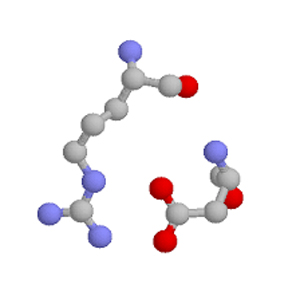
به آن بخش از مولکول پپتید که تأثیر مشخصی دارد، توالی فعال می گویند که از به هم چسبیدن چند اسید آمینه خاص ایجاد می شود.
.jpg)
دی سدیم کوکوئیل گلوتامات سورفکتانت آمفوتری است که ساختاری شبیه بتائین ها دارد. با این تفاوت که بر خلاف بتائین ها که هسته اصلی شان اسید آمینه گلایسین است، دی سدیم کوکوئیل گلوتامات از گلوتامیک اسید مشتق شده است.

مطلب فوق را در شبکه های اجتماعی زیر با دوستانتان به اشتراک بگذارید
